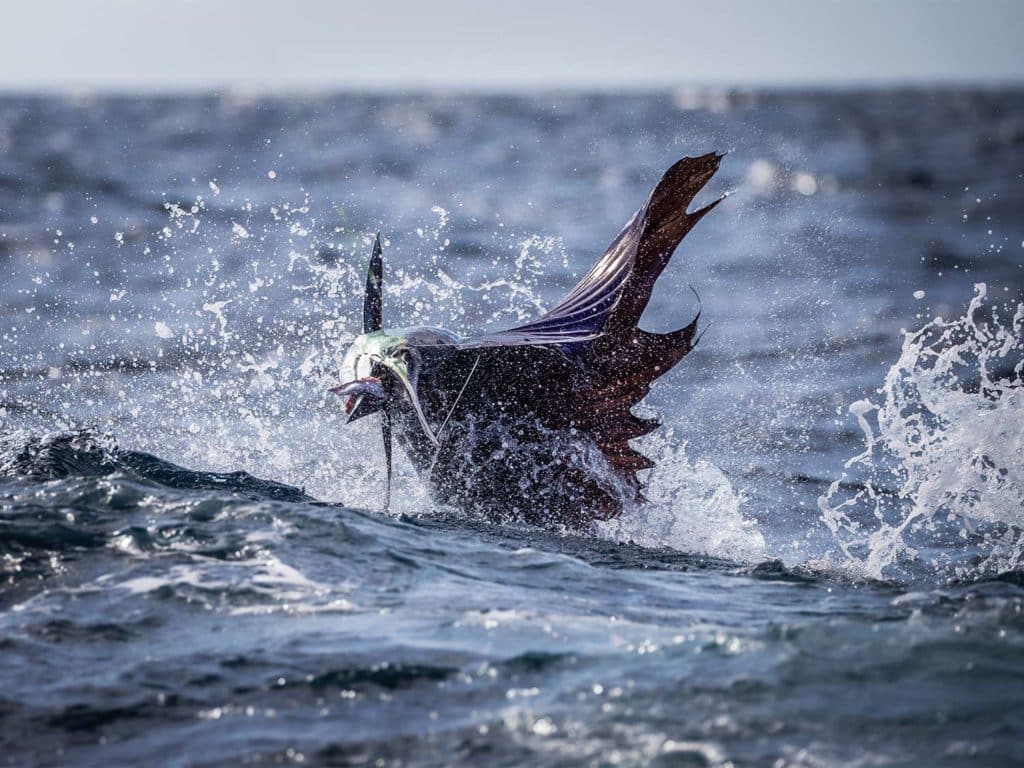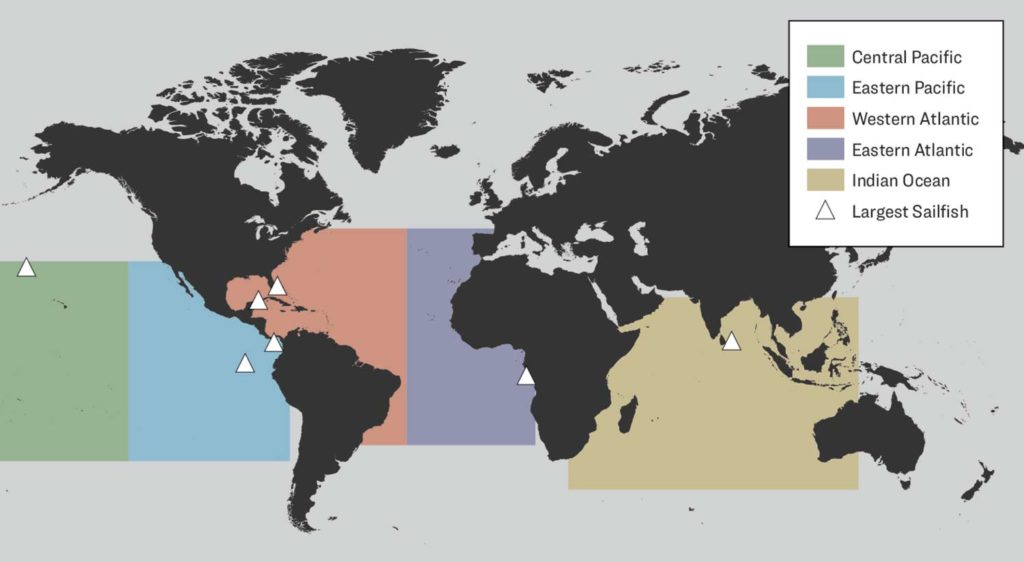
Special delivery: Sign up for the free Marlin email newsletter. Subscribe to Marlin magazine and get a year of highly collectible, keepsake editions – plus access to the digital edition and archives.
To complete my Masters of Professional Science degree at the University of Miami, I participated in the IGFA Conservation Internship Program under the direction of Dr. Bruce Pohlot. The program had me focus on the scientific analysis of sailfish size and distribution. The analysis used available size data from regional fishery-management organizations and nongovernmental organizations to compare size frequencies and asymptotic length of sailfish around the globe.
By noting the size contrasts between individuals in the Atlantic and the Pacific, as well as comparing them with other ocean basins to determine what environmental and oceanographic factors could lead to differences in sailfish size, the analyzed data of more than 104,000 individual sailfish indeed showed a significant size difference. The data also provided some great insight into the relationship large sailfish have with their environment.
Generally, sailfish follow a similar diving pattern to other billfish, where they remain in the upper water column most of the time and dive to deeper depths only during the daytime, but rarely for very long. Sailfish consume a wide selection of prey items, feeding mainly on epipelagic—or surface-oriented—species in coastal and oceanic waters. They commonly feed on bony fishes such as bullet tuna, ballyhoo, sardines and anchovies, and are also known to consume cephalopods such as paper nautilus and squid. In some areas, they will even feed on bottom-dwelling fish such as sea robins. Due to this varied diet, sailfish are thought to adopt an opportunistic feeding strategy, to seek prey that is more available rather than their preferred food items.
Watch: Take a ride on Wall Hanger, a waterjet-powered beauty from Spencer Yachts.
Currents and Habitat
The foundation of the open-ocean ecosystem is phytoplankton. These microscopic plants harness the sun’s light to produce organic carbon for nearly every animal in the ocean, using nutrients such as phosphates and nitrates that are brought to surface waters through upwelling systems to produce the organic matter. Some of the world’s most productive oceans and largest fish populations are associated with coastal upwelling systems.
Areas where oceanic currents parallel the eastern boundaries of oceans have been shown to have the most productive upwelling systems. These currents, such as the California and Humboldt currents in the eastern Pacific and the Canary and Benguela currents off western Africa, support large populations of small pelagic fish such as anchovies and sardines. However, these highly productive areas can also hold large regions of hypoxic (low-oxygen) water where few animals can reside.
Depth distributions of sailfish in the eastern tropical Pacific and Atlantic have showed that this hypoxic environment can establish a lower habitat boundary in these regions where areas of hypoxic water can compress the habitat for not only sailfish, but their prey as well.
Habitat compression in these regions concentrate prey in surface waters, making the billfish more available to anglers. But this also makes them more vulnerable to harvest from surface-oriented commercial fisheries. These regions seem to allow sailfish to hunt more efficiently without having to dive deeper to find prey items due to the prey being forced to the upper water column, where sufficient oxygen is available.

Size Data
Regional fishery-management organizations are international bodies made up of countries that share practical and/or financial interest in managing and conserving highly migratory species stocks in a particular region. Together, five tuna RFMOs have the responsibility of managing fisheries in approximately 91 percent of the world’s oceans. The entirety of this study was conducted using data acquired from three of them: the International Commission for the Conservation of Atlantic Tunas, the Indian Ocean Tuna Commission, the Inter-American Tropical Tuna Commission, as well as NOAA’s Pacific Island Fisheries Science Center and the International Game Fish Association. The data included location and sailfish length from a variety of different commercial fisheries and tagging programs from 1990 to present, and were combined with IGFA world-record data to compare five ocean basins, which were determined by RFMO designations of billfish stocks, data availability, and environmental/oceanographic boundaries of the central Pacific Ocean, eastern Pacific Ocean, western Atlantic Ocean, eastern Atlantic Ocean, and the Indian Ocean.
To compare sailfish size across these basins, sizes were classified based on the percent of fish of that size from the region. Fish were grouped into six percentile classes, and in total, 104,949 individual sailfish lengths and five locations were used in the analysis of this study.
The eastern Atlantic and eastern Pacific had the two largest average sizes at 80.3 inches and 73.6 inches respectively. The eastern Atlantic presented the greatest 90th-percentile size at 96.5 inches, meaning the top 10 percent of fish in the eastern Atlantic were larger than any other region analyzed. The western Atlantic had an average size of 71.7 inches, and the Indian Ocean’s average sailfish were just a bit smaller at 70.9 inches.
In three out of the five ocean basins, the largest individual was a record reported by the IGFA; however, in the western Atlantic and the Indian Ocean, the maximum size reported was larger than IGFA’s world record, with the biggest sailfish coming from the western Atlantic at 144.1 inches.
The eastern Pacific showed a wide distribution of smaller sailfish throughout the Gulf of California and into the Central American coastline. The larger fish seem to congregate farther south around the coasts of Guatemala and Costa Rica.
While both hemispheres of the eastern Pacific have currents that cause upwellings, studies have shown that the Humboldt Current is more productive than the California Current and could be the reason for the greater size of predatory billfish in the Southern Hemisphere of the eastern Pacific.
The Indian Ocean had the most sailfish data of any region, with an astonishing 76,227 individuals. The average size in this region was 70.9 inches, where smaller fish were common around the southern tip of India and Sri Lanka. Larger fish were evenly distributed throughout the ocean but seem to have a concentration in the northwest region of Australia.
The western Atlantic region included data from hook-and-line fishing, and the biggest fish in the entirety of this study was recorded here at 144.1 inches. But before you go out in search of similar-size monsters, you must know that this region also tends to have smaller sailfish, averaging around 71.7 inches. The smaller individuals appear throughout the Caribbean and Gulf of Mexico, whereas the larger specimens seem to congregate off Venezuela.
The eastern Atlantic had the smallest dataset analyzed, containing 199 individuals mostly from hook-and-line fisheries, with an average size of 80.3 inches—which was the largest average size out of all regions reviewed. The smaller fish have an even distribution throughout the African coastline, although larger ones seem to make their home off the southwestern Central African coast near Gabon and Angola, as well as off the coast of Senegal in West Africa.
Read More: Learn more about the past, present and future of the Offshore World Championship.
Findings
This study sought to determine how the physical, biological and ecological dynamics of different ocean basins could affect the size of sailfish. We found that the largest average sizes occurred in both eastern ocean basins, leading us to believe that larger individuals are in fact found in areas with eastern boundary currents.
The study also seems to reflect what is to be expected in these highly fertile ocean basins: That a more productive area will be able to maintain a more abundant prey population, therefore supporting more (and larger) predators. This, coupled with habitat compression, makes a target-rich environment for sailfish to go hunting.
These findings add to our understanding of how sailfish are distributed within the world’s ocean basins. Understanding sailfish growth and asymptotic size is crucial to the conservation and assessment of them in specific regions. Also, understanding how sailfish size relates to ecosystem dynamics is helpful to better understand how they will react as oxygen-minimum zones continue to grow farther westward and become shallower.







